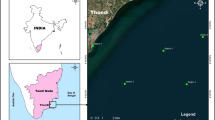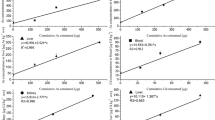Abstract
This investigation was aimed at determining the concentration levels of five toxic heavy metals (lead, cadmium, chromium, arsenic, and mercury) in dried Porphyra and Laminaria samples from coastal city of China. Inductively coupled plasma-mass spectrometry (ICP-MS) was used for determination of lead, cadmium and total arsenic. Atomic fluorescence spectrometry was used for mercury, and liquid chromatography coupled with ICP-MS was used for arsenic speciation. The mean concentrations of lead, cadmium, chromium, total arsenic, and mercury were 0.96 ± 0.03 mg/kg, 2.62 ± 0.07 mg/kg, 1.64 ± 0.08 mg/kg, 36.67 ± 0.53 mg/kg, and 7.56 ± 0.42 μg/kg for Porphyra samples and 0.61 ± 0.03 mg/kg, 0.48 ± 0.02 mg/kg, 3.78 ± 0.56 mg/kg, 43.85 ± 1.42 mg/kg, and 46.61 ± 2.02 μg/kg for Laminaria samples. The results were comparable with previous similar research. The potential health risk assessment was conducted by comparing the calculated weekly intakes of toxic metals from Porphyra and Laminaria with provisional tolerable weekly intake. Consumption of these seaweeds does not seem to pose a risk for the consumers’ health regarding their content of heavy metals. However, the potential health risk of cadmium should not be overlooked for consumers with high intake of Porphyra.


Similar content being viewed by others
Data Availability
All data and materials generated or used during the study appear in the submitted article.
References
FAO (2002) Prospects for seaweed production in developing countries. Report No. 968 FIIU/C968(En). http://www.fao.org/3/Y3550E/Y3550E00.htm. Accessed 16 January 2020
Jiménez-Escrig A, Gómez-Ordóñez E, Rupérez P (2012) Brown and red seaweeds as potential sources of antioxidant nutraceuticals. J Appl Physiol 24(5):77–86
Khan N, Ryu KY, Choi JY, Nho EY, Habte G, Choi H, Kim KS (2015) Determination of toxic heavy metals and speciation of arsenic in seaweeds from South Korea. Food Chem 169:464–470
FAO (2018) The global status of seaweed production, trade and utilization. Globefish Res Program 124:120
Kato K, Hayashi M, Umene S, Masunaga H (2016) A novel method for producing softened edible seaweed kombu. LWT Food Sci Technol 65:618–623
Circuncisão A, Catarino M, Cardoso S, Silva A (2018) Minerals from macroalgae origin: health benefits and risks for consumers. Mar Drugs 16(11):400
Yu LL, Wei C, Zeisler R, Tong JT, Oflaz R, Bao HX, Wang J (2015) An approach for identification and determination of arsenic species in the extract of kelp. Anal Bioanal Chem 407(12):3517–3524
Arulkumar A, Nigariga P, Paramasivam S, Rajaram R (2019) Metals accumulation in edible marine algae collected from Thondi coast of Palk Bay, Southeastern India. Chemosphere 221:856–862
Kacie KH, Benjamin WR (2020) Impact of thermal processing on the nutrients, phytochemicals, and metal contaminants in edible algae. Crit Rev Food Sci Nutr:1–19. https://doi.org/10.1080/10408398.2020.1821598
Redan BW (2020) Processing aids in food and beverage manufacturing: potential source of elemental and trace metal contaminants. J Agric Food Chem 68:13001–13007. https://doi.org/10.1021/acs.jafc.9b08066
Sanders T, Liu Y, Buchner V, Tchounwou PB (2009) Neurotoxin effects and biomarkers of lead exposure: a review. Rev Environ Health 24:15–45
Padrón P, Paz S, Rubio C, Gutiérrez ÁJ, González-Weller D, Hardisson A (2020) Trace element levels in vegetable sausages and burgers determined by ICP-OES. Biol Trace Elem Res 194(2):616–626
Costa M (2019) Review of arsenic toxicity, speciation and polyadenylation of canonical histones[J]. Toxicol Appl Pharmacol 375:1–4
NHCC (2017) National Food Safety Standard of -Maximum Levels of Contaminants in Food. https://sppt.cfsa.net.cn:8086/staticPages/D5921FFE-BD08-4D34-AE26-CF9CA4FEB001.html. Accessed 06 May 2020
Zhao R, Yan S, Liu M, Wang B, Fan C (2016) Seafood consumption among Chinese coastal residents and health risk assessment of heavy metals in seafood. Environ Pollut Res Int 23(16):16834–16844
Olmedo P, Pla A, Hernández AF, Barbier F, Ayouni L, Gil F (2013) Determination of toxic elements (mercury, cadmium, lead, tin and arsenic) in fish and shellfish samples. Risk assessment for the consumers. Environ Int 59:63–72
Paz S, Rubio C, Frías I, Luis-González G, Gutiérrez ÁJ, González-Weller D, Hardisson A (2019) Human exposure assessment to macro- and trace elements in the most consumed edible seaweeds in Europe. Environ Sci Pollut Res 26(2):36478–36485
Smith JL, Summers G, Wong R (2010) Nutrient and heavy metal content of edible seaweeds in New Zealand. New Zeal J Crop Hort 38(1):19–28
Chakraborty S, Bhattacharya T, Singh G, Maity JP (2014) Benthic macroalgae as biological indicators of heavy metal pollution in the marine environments: a biomonitoring approach for pollution assessment. Ecotox Environ Safe 100:6–68
Astorga-España MS, Rodríguez Galdón B, Rodríguez Rodríguez EM, Díaz Romero C (2015) Mineral and trace element concentrations in seaweeds from the sub-Antarctic ecoregion of Magallanes (Chile). J Food Compos Anal 39:69–76
Wolle MM, Conklin SD (2018) Speciation analysis of arsenic in seafood and seaweed: part II-single laboratory validation of method. Anal Bioanal Chem 410(22):5689–5702
Nam SH, Oh HJ, Min HS, Lee JH (2010) A study on the extraction and quantitation of total arsenic and arsenic species in seafood by HPLC–ICP-MS. Microchem J 95(1):20–24
NHCC (2014) National Food Safety Standard-Determination of Total Mercury and Organic Mercury in Food. https://sppt.cfsa.net.cn:8086/staticPages/80758443-0689-43A7-9BFE-ABCB9E3C6F4F.html. Accessed 06 May 2020
Chudzinska M, Baralkiewicz D (2011) Application of ICP-MS method of determination of 15 elements in honey with chemometric approach for the verification of their authenticity. Food Chem Toxicol 49(11):2741–2749
Almela C, Algora S, Benito V, Clemente M, Devesa V, Suner M et al (2002) Heavy metal, total arsenic, and inorganic arsenic contents of algae food products. J Agric Food Chem 50(4):918–923
Almela C, Clemente MJ, Vélez D, Montoro R (2006) Total arsenic, inorganic arsenic, lead and cadmium contents in edible seaweed sold in Spain. Food Chem Toxicol 44(11):1901–1908
Caliceti M, Argese E, Sfriso A, Pavoni B (2002) Heavy metal contamination in the seaweeds of the Venice lagoon. Chemosphere 47(4):443–454
Chen Q, Pan XD, Huang BF, Han JL (2018) Distribution of metals and metalloids in dried seaweeds and health risk to population in southeastern China. Sci Rep 8:3578
Lu B, Liu XB (2011) Analysis of food pollutant surveillance concerning lead, cadmium and aluminum in Chang-ping District of Beijing in 2009. Mod Prev Med 38(5):854–856 (in Chinese)
Tang JC, Hu SH, Meng YH (2011) Determination and analysis of lead and cadmium in contaminants in foods from Guangdong province in 2009-2010. Chinese J Health Lab Technol 21(3):703–707 (in Chinese)
Muse JO, Stripeikis JD, Fernández FM, d’Huicque L, Tudino MB, Carducci CN, Troccoli OE (1999) Seaweeds in the assessment of heavy metal pollution in the Gulf San Jorge, Argentina. Environ Pollut 104(2):315–322
Pérez AA, Farías SS, Strobl AM, Pérez LB, López CM, Piñeiro A, Roses O, Fajardo MA (2007) Levels of essential and toxic elements in Porphyra columbina and Ulva sp. from San Jorge Gulf, Patagonia Argentina. Sci Total Environ 376(1–3):51–59
Połeć-Pawlak K, Ruzik R, Abramski K, Ciurzyńska M, Gawrońska H (2005) Cadmium speciation in Arabidopsis thaliana as a strategy to study metal accumulation system in plants. Anal Chim Acta 540(1):61–70
Leal MCF, Vasconcelos MT, Sousa-Pinto I (1997) Biomonitoring with benthic macroalgae and direct assay of heavy metals in seawater of the Oporto coast (Northwest Portugal). Mar Pollut Bull 34(12):1006–1015
Zhao YF, Wu JF, Shang DR, Ning JS, Zhai YX, Sheng XF, Ding HY (2015) Subcellular distribution and chemical forms of cadmium in the edible seaweed, Porphyra yezoensis. Food Chem 168:48–54
Besada V, Andrade JM, Schultze F, Gonzalez JJ (2009) Heavy metals in edible seaweeds commercialised for human consumption. J Mar Syst 75(1–2):305–313
Rubio C, Napoleone G, Luis-González G, Gutiérrez AJ, González-Weller D, Hardisson A, Revert C (2017) Metals in edible seaweed. Chemosphere 173:572–579
EC (2004) Draft report from task 3.2.11: Assessment of the dietary exposure to arsenic, cadmium, lead and mercury of the population of the EU member states. European Commission, Directorate-General Health and Consumer Protection, Reports on tasks for scientific co-operation, final draft, March 2004. http://ec.europa.eu/food/food/chemicalsafety/contaminants/scoop_3-2-11_heavy_metals_report_en.pdf/ Accessed 16 January 2020
EC (2014) Commission Regulation (EC) No. 488/2014. Amending Regulation (EC) No. 1881/2006 as regards maximum levels for cadmium in foodstuffs. Off J Euro Union, L138/75–79
Moreda-Pineiro A, Bermejo-Barrera A, Bermejo-Barrera P (2007) Concentrations of iodide and total iodine in edible seaweeds harvested on the Galician coast (Northwest Spain). Bot Mar 50(1):65–71
Ródenas de la Rocha S, Sánchez-Muniz FJ, Gómez-Juaristi M, Larrea Marín MT (2009) Trace elements determination in edible seaweeds by an optimized and validated ICP-MS method. J Food Compos Anal 22(4):330–336
Sánz E, Munoz-Olivas R, Cámara C (2005) Evaluation of a focused sonication probe for arsenic speciation in environmental and biological samples. J Chromatogr A 1097(1–2):1–8
Van Hulle M, Zhang C, Zhang XR, Cornelis R (2002) Arsenic speciation in Chinese seaweeds using HPLC-ICP-MS and HPLC-ES-MS. Analyst 127(5):634–640
Terol A, Ardini F, Grotti M, Todoli JL (2012) High temperature liquid chromatography-inductively coupled plasma mass spectrometry for the determination of arsenosugars in biological samples. J Chromatogr A 1262(2):70–76
Feldmann J, Krupp EM (2011) Critical review or scientific opinion paper: arsenosugars-a class of benign arsenic species or justification for developing partly speciated arsenic fractionation in foodstuffs? Anal Bioanal Chem 399(5):1735–1741
Australia New Zealand Food Standards Code. Standard 1.4.1-Contaminants and Natural Toxicants. https://www.comlaw.gov.au/Details/F2015C00052/. Accessed 16 January 2020
Chen YC, Chen MH (2006) Mercury levels of seafood commonly consumed in Taiwan. J Food Drug Anal 14(4):373–378
Astorga-España MS, Calisto-Ulloa NC, Guerrero S (2008) Baseline concentrations of trace metals in macroalgae from the Strait of Magellan, Chile. Bull Environ Contam Toxicol 80(2):97–101
Naseri M, Vazirzadeh A, Kazemi R, Zaheri F (2015) Concentration of some heavy metals in rice types available in Shiraz market and human health risk assessment. Food Chem 175:243–248
JECFA (2003) Summary and conclusions of the sixty-first meeting of the Joint FAO/WHO Expert Committee on Food Additives. http://www.who.int/pcs/jecfa/Summary61.pdf/. Accessed 16 January 2020
JECFA (2006) Summary and conclusions of the sixty-seventh meeting of the Joint FAO/WHO Expert Committee on Food Additives. ftp://ftp.fao.org/ag/agn/jecfa/jecfa67_final.pdf/. Accessed 16 January 2020
JECFA (2010) Summary and conclusions of the seventy-second meeting of the Joint FAO/WHO Expert Committee on Food Additives. http://wwwwhoint/foodsafety/chem/summary72_revpdf/ Accessed 16 January 2020
Zava TT, Zava DT (2011) Assessment of Japanese iodine intake based on seaweed consumption in Japan: a literature based analysis. Thyroid Res 4(1):14
MEPC (2013) Exposure factors handbook of Chinese population (adult). China Environmental Science Press, Beijing
SCF (1993) Nutrient and energy intakes for the European Community. In Reports of the Scientific Committee on Food, thirty first series. Luxembourg: EC
Funding
This work was financially supported by the National Nature Science Foundation of China (No. 41401367) as well as Key Laboratory of Agricultural Product Quality and Safety Risk Assessment, Guangdong Province(2019) (No. 2019B121203009).
Author information
Authors and Affiliations
Contributions
Yan Chen contributed to sample determination and manuscript preparation, Yong-tao Liu contributed to the sample collection and data analysis, Fu-hua Wang contributed to the study design, Dian Wen contributed to the statistic analysis, Hui Yang contributed to the literature search, and Xiao-li Zhao contributed to the language editing.
Corresponding author
Ethics declarations
Conflicts of Interest
The authors declare that they have no conflict of interest.
Code Availability
Not applicable.
Additional information
Publisher’s Note
Springer Nature remains neutral with regard to jurisdictional claims in published maps and institutional affiliations.
Supplementary Information
ESM 1
(PDF 102 kb)
Rights and permissions
About this article
Cite this article
Chen, Y., Liu, Yt., Wang, Fh. et al. An Investigation of Toxic Metal Levels (Pb, Cd, Cr, As, Hg) in Dried Porphyra and Laminaria Collected from Coastal Cities, China. Biol Trace Elem Res 199, 3987–3997 (2021). https://doi.org/10.1007/s12011-020-02509-w
Received:
Accepted:
Published:
Issue Date:
DOI: https://doi.org/10.1007/s12011-020-02509-w




